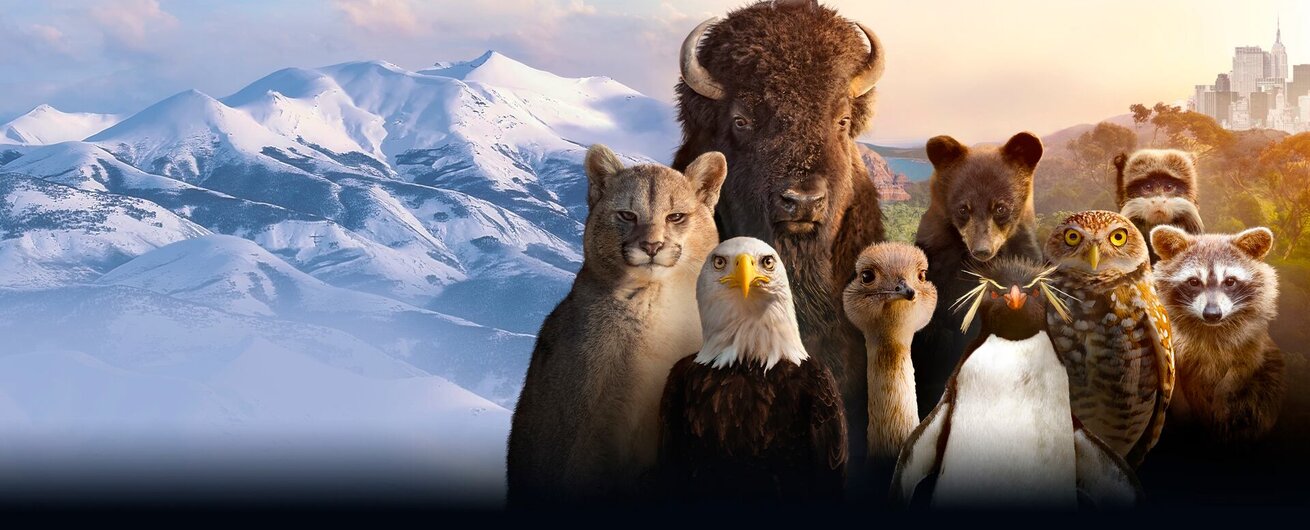Everything to Know About Patagonia, One of the Coolest Places in The Americas
Visit the varied landscapes and incredible creatures of Patagonia, on The Americas.
The Americas are a vast continental landmass stretching from the northern reaches of Canada and Alaska to the southern tip of Chile and harboring the widest variety of life on the planet. The 10-episode documentary spectacular The Americas tells the untold stories of North, Central, and South America, showcasing the most incredible environments and animals on Earth.
So far, we’ve visited the snowshoe hares of the frozen north, hung out with giant Pacific octopuses off the west coast, and watched the death-defying antics of the marbled four-eyed frog in the Andes. Now we’re visiting Patagonia, the southernmost part of South America (just 600 miles from Antarctica), where the Southern, Pacific, and Atlantic oceans meet.
Pumas vs guanacos in the Patagonian Andes
The Andes are the backbone of South America, running north to south for more than 1,000 miles. At its craggy peaks the weather can be extreme, shifting through wintry snowfalls and harsh high temperatures all in a single day.
The constantly shifting landscape can be a challenge for large South American cats looking for a meal. The largest predator in Patagonia, adult female pumas weigh in at about 110 pounds and stretch 10 to 12 feet, with golden-colored fur. They have territorial ranges of about 40 square miles and live mostly solitary lives, coming together only to breed and occasionally to share meals.
RELATED: Tom Hanks & Executive Producer Mike Gunton on the Unique Challenges of Making The Americas
Pumas reach sexual maturity between 1.5 and 3 years of age and have a litter every 2 or 3 years. After a 3-month gestation period, female pumas deliver an average of 2 but as many as 6 kittens. The babies are born blind and weigh only about a pound at birth. Small black spots on their coat help them to blend into the landscape and fade as they grow and become more self-sufficient. Newborns nurse for about 3 months and by the time they’re 8 months old they weigh approximately 45 pounds and are large enough to start hunting on their own, with help from mom. When they’re big enough, they’ll be able to take down the Patagonian puma’s favorite prey: guanacos.
Even if you’ve never seen a guanaco before, they’ll look familiar. They are a wild camelid species closely related to alpacas and llamas. In fact, llamas don’t exist in the wild and were domesticated from guanacos. They stand about 3.5 feet tall at the shoulder and weigh between 200 and 300 pounds when fully grown.
You can find guanacos in the forests, grasslands, shrublands, and deserts of Argentina, Chile, and Peru. In the arid landscapes of Patagonia, guanacos get much of the water they need from grazing on grasses and other plants. In a pinch, they’ll also chow down on cacti, flowers, fruit, and lichen. Most of the time, they live a relatively slow-moving life, but they can get the lead out when they need to. When frightened, a guanaco can run as quickly as 35 miles per hour. That’s fast enough for them to escape almost any predator, except for the puma.
When a puma and guanaco come face to face in the wilds of Patagonia, success or failure, life and death, depend on who’s faster and who has the better aim. To bring a guanaco down, the puma needs to latch on and deliver a killing bite to the neck. If it fails, a single kick from the guanaco could spell the end for the puma and her kittens.
Stag beetles battle for mates in the treetops of Patagonia
Along Patagonia’s western coast there are forests filled with brightly colored mushrooms and battling Chilean stag beetles. Their oversized jaws look like antlers erupting from their heads. Much like the deer from which they get their common name, stag beetles use their antler-like jaws in head-to-head battles.
First, male beetles detect the scent of a female in the air. She’s perched in the branches of a tall tree and, while stag beetles can fly, they struggle to fly that high. Instead, a stag beetle suitor flies to the vicinity, lands on the trunk, and begins a long climb. Leg over leg, he lumbers 100-feet up, toward the treetops. That’s the equivalent of a human climbing a tree half a mile high.
RELATED: Flamingos Showing Off Their Mating Dance on The Americas Is Absolutely Hypnotizing (WATCH)
It would be an overwhelming endeavor even without interruptions, but there are other stag beetles in the way. They fight among the branches, each one using his oversized jaws to grapple and throw his opponent. With a well-timed flick of the head, the rival falls to the forest floor, but there are other contenders and winning one fight isn’t the same as sinning the day. Stag beetles must endure a single elimination challenge for the chance to reproduce.
When the fighting is done, our weary 6-legged warrior finally meets his mate. They share a brief embrace and then it’s time for her to lay her eggs on the forest floor, 100 feet down. Fortunately, there’s a quick way to get there and her new paramour has plenty of practice. He ends the day by throwing one more beetle over the edge to the leaf litter below.
The watery warfare of orcas and elephant seals on the Patagonian coast
Southern pressure systems drive intense weather across Patagonia. In addition to intense temperature fluctuations, dust storms scrape across the landscape traveling more than 70 miles per hour. The storms are so large they can be seen from orbit, and they carry millions of tons of nutrient-rich dust to the sea.
That dust helps to support robust ocean ecosystems, from the smallest plankton to the massive elephant seals that call the coast home. Full grown males are the size of a pickup truck with elongated trunk-like noses. They aren’t the prettiest creatures on the planet, but they don’t have to be.
Every year, approximately 60,000 elephant seals gather along Peninsula Valdez to breed, but not everyone will get the chance. Male elephant seals hold harems of multiple mates, so if you want to reproduce you first have to claim a spot near the top of the social hierarchy.
RELATED: The Americas Highlights Superheated Rivers of the Andes & the Super Ducks Who Live There
If a rival appears, male elephant seals defend their families violently. Those trunk-like noses amplify their warning calls to a staggering 130 decibels, roughly the same volume as a jackhammer. If that’s not enough to scare off an interloper, then it’s time to fight. Elephant seals lumber of sand and rocks, baring sharp teeth and slam their impressive girth into their opponent. During a battle, they tower 10 feet tall, swinging their sharp teeth into the neck and body of their rival. It’s a bloody affair, but it’s not usually deadly. Of course, rival males aren’t the only thing elephant seals have to worry about.
Orcas hunt the waters off the Patagonian coast and, while you might think elephant seals would be safe on land, that isn’t always the case. A small subset of 16 killer whales have learned an unusual but effective hunting technique that allows them to grab a quick meal from dry land.
Along the coast, you can find lagoons separated from the ocean by sand banks. There, calm waters make a good home for young elephant seals to grow up. It’s also the ideal training ground for hunting orcas.
Catching a seal from the shore means launching themselves toward land and nearly beaching themselves in the process. Overshoot, and an orca could end up stranded but when that happens the others come to the rescue.
Get the timing right, however, and an orca can race toward a seal on the shore, snatch it from dry land, and pull it back into the drink. They’ve even learned to swim on their side, obscuring the dorsal fin and remaining stealthy until they are ready to strike. It’s a unique relationship and a unique way of life, only found in Patagonia.
Where to watch The Americas
New episodes of The Americas air weekly Sundays at 8:00 p.m. ET on NBC, and stream on Peacock the following day!








































